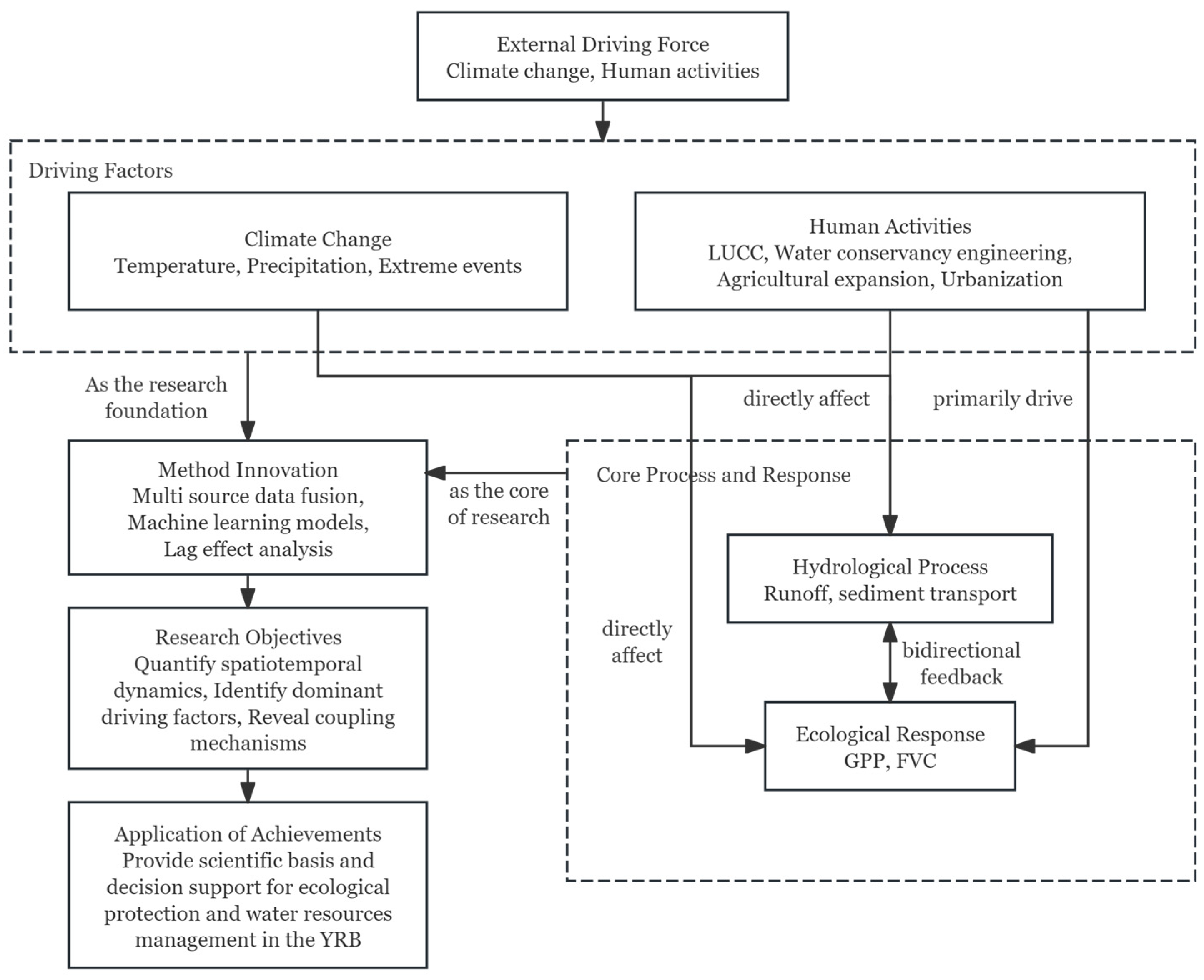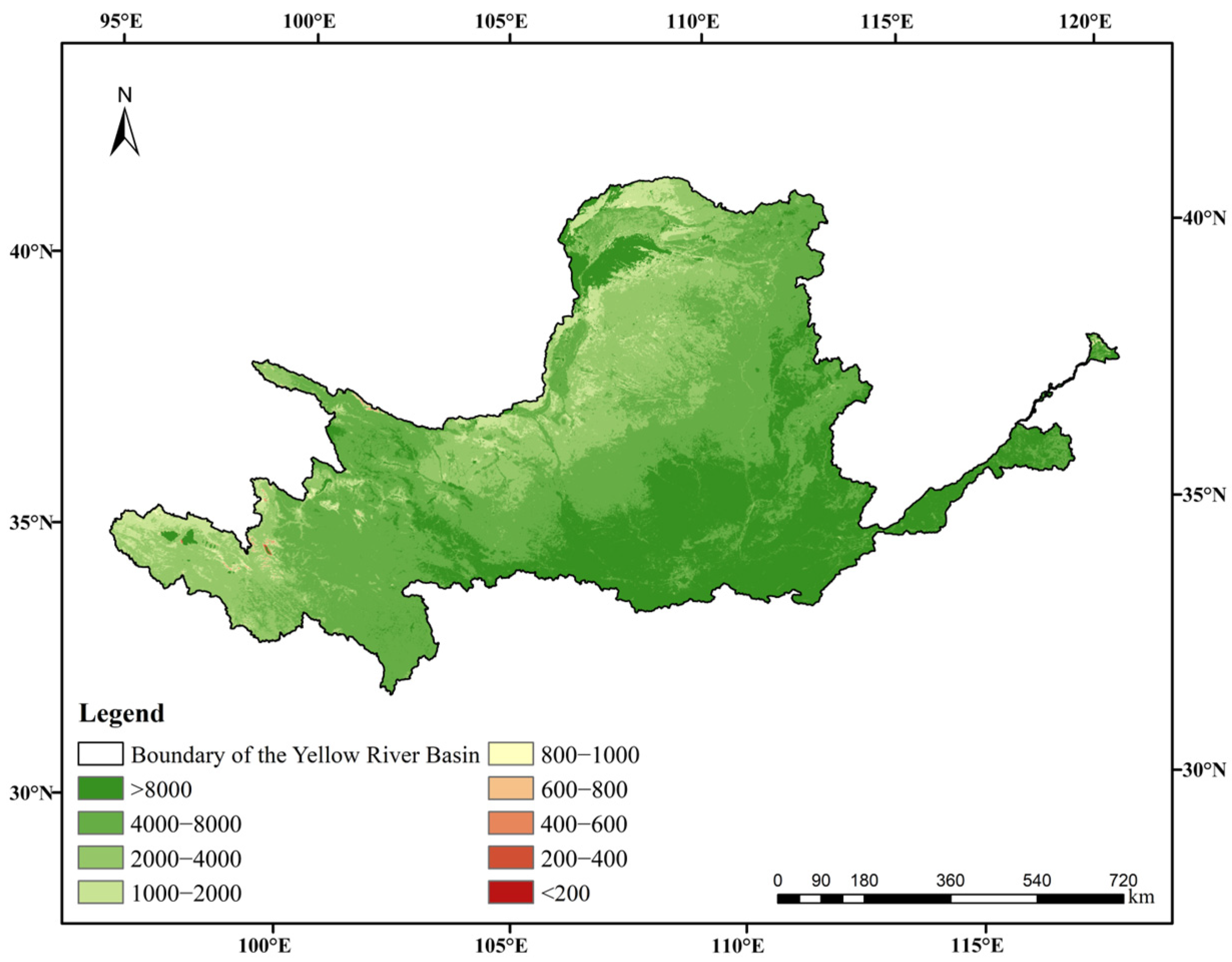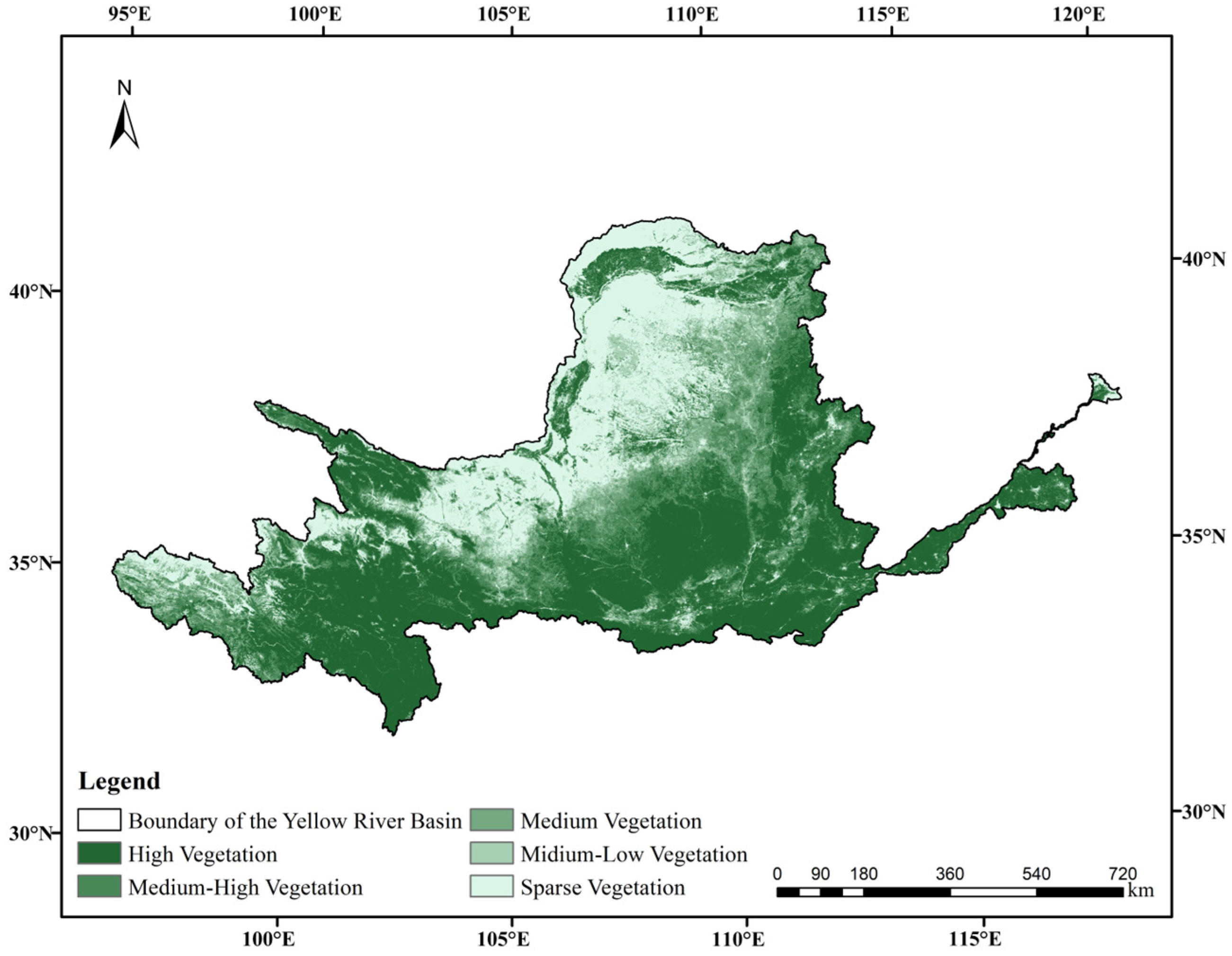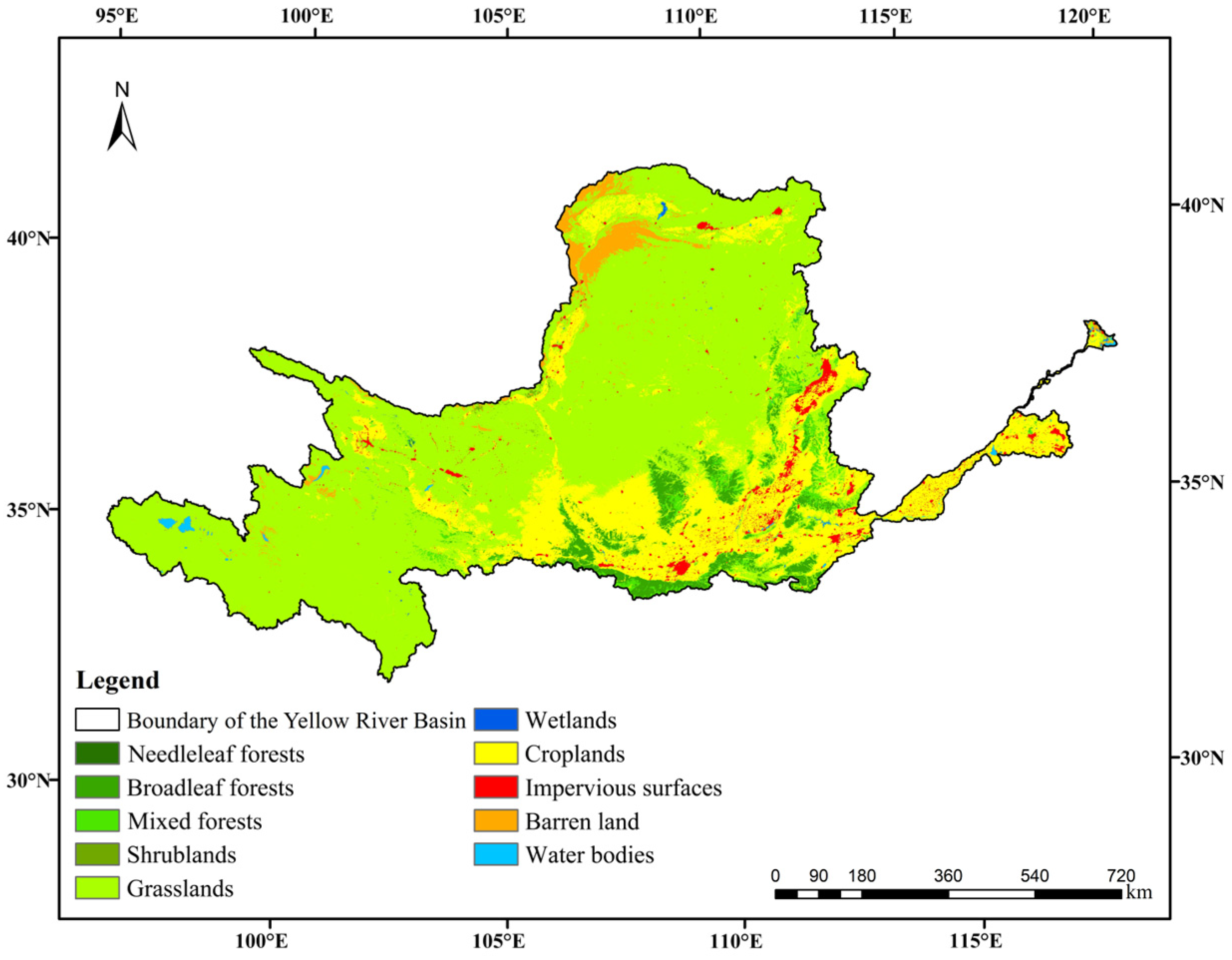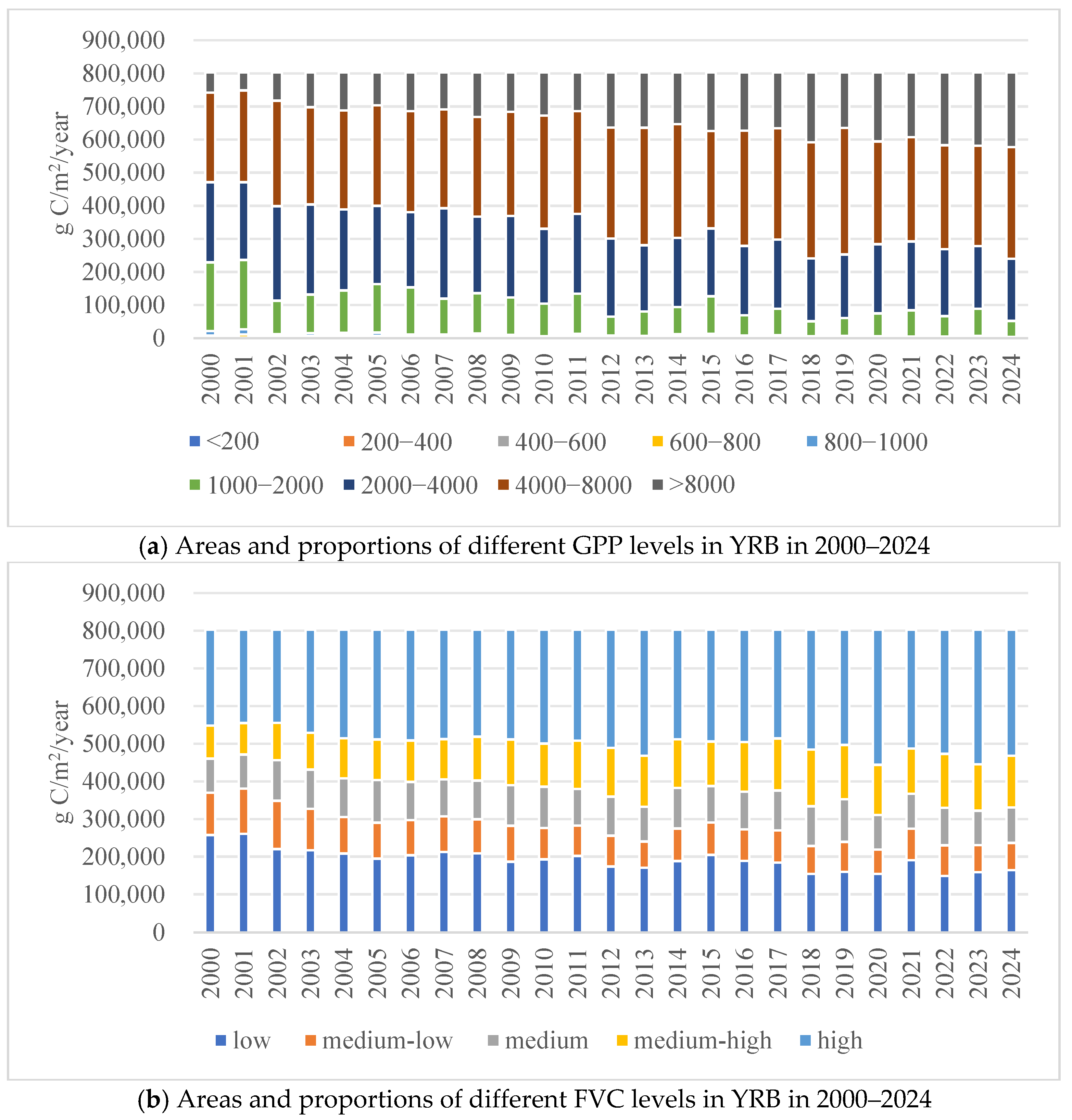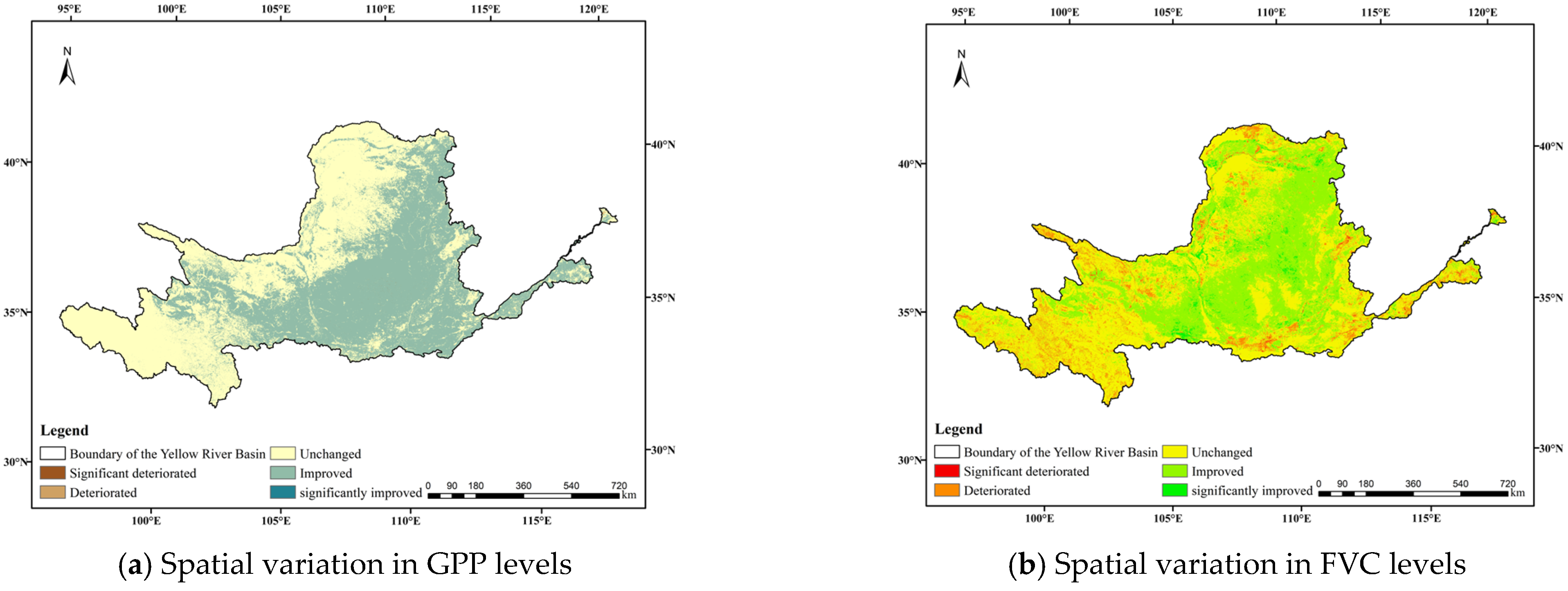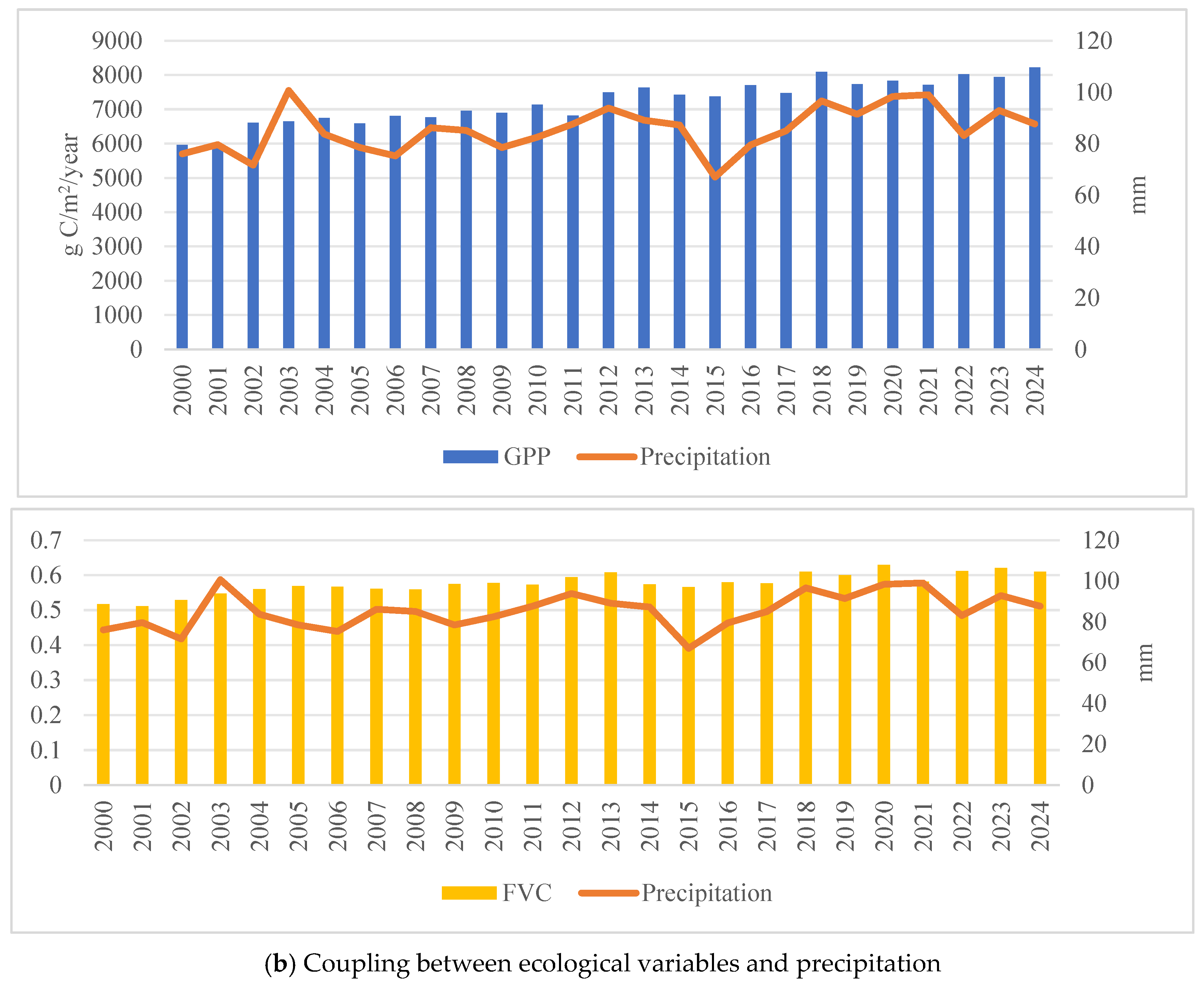1. Introduction
The Yellow River Basin (YRB), the cradle of Chinese civilization and a key ecological zone in northern China [
1], has long faced escalating ecological threats from climate change and intensified human activities, including severe soil erosion and ecosystem degradation [
2,
3,
4]. Scientific interventions are required to resolve these challenges and balance ecological security protection with socio-economic development.
Globally, studies on ecological environmental dynamics have experienced three stages of development over the years: (1) Earlier research focused on the impacts of one specific single factor on the ecological environment or qualitative analyses of anthropogenic impacts [
5,
6,
7], which often overlooked the complexity of the ecological environmental system. (2) Studies later utilized multi-source remote-sensing data to quantify the spatiotemporal evolution of key ecological indicators, such as the gross primary productivity (GPP)—a key indicator of ecosystem carbon cycling [
8,
9,
10], and identify the key drivers of different landscapes [
11,
12]. (3) Recent studies incorporated carbon–water coupling analysis to unveil biogeochemical feedbacks [
13,
14] and assess the response of regional ecosystems to global changes through process-based ecosystem modeling [
15,
16,
17]. The research methodologies in this domain have also advanced from traditional statistical analysis to machine learning frameworks [
18,
19] and physics constraint models; these models, by assimilating field observations with satellite data, increased the prediction accuracy of nonlinear ecological behaviors.
In this global context, research on the dynamic evolution of the ecological environment in YRB has made significant but unsystematic progress. Some pioneering studies identified the correlation between climate variables and vegetation dynamics, using the MODIS-derived products of GPP and fractional vegetation cover (FVC) to predict the greening trends across the basin in relation to global warming and eco-protection policies [
18,
20]. For instance, Lin et al. [
21] examined the impacts of climate change on the water-carbon utilization efficiency in YRB by analyzing the trajectory of the normalized difference vegetation index (NDVI); Xue et al. [
12] quantified the influence of extreme droughts on the vegetation productivity in the basin. Studies on the land use and land cover change (LUCC) in YRB investigated the mechanism underlying the transitions from natural ecological landscapes to urban land, and attributed these transitions to agricultural expansion and construction of hydraulic engineering projects [
3,
22,
23]. Some hydrological studies in YRB measured the variations in the runoff and sediment flux in the upper, middle, and lower reaches of the basin, and identified the correlations between the sediment flux and erosion control challenges [
3,
24]. Despite these previous research efforts, limitations remain: (1) The low resolution of currently available datasets of YRB failed to reflect the regional heterogeneity in the Loess Plateau and other topographically complex areas, resulting in uncertainties in the inversion of GPP. (2) In previous works, the bi-directional feedback between the ecological variables and the hydrological processes was disregarded: though some examined the precipitation-runoff interactions [
25,
26], the lagged effects of sediments on vegetation recovery were not examined. (3) Though LUCC [
22,
23], climate [
2], and hydrological factors were identified as the co-drivers for ecological environmental variations in YRB, quantitative evaluation of the interactions between these driving factors based on spatially explicit modeling was lacking; (4) the conflict between three staircase topography [
24], vegetation gradient [
27], and intensive human activities [
3] in YRB has led to unique thresholds of ecological variations in the basin, but most prediction models failed to interpret the complex correlations between the variables involved [
20,
21,
28,
29,
30,
31,
32].
The limitations specified above allowed us to identify the research direction on the macro-ecological environmental variations in YRB—to shift from unsystematic and correlation-based analyses to establishing a comprehensive ecological and hydrological framework that could quantify cross-scale correlations and mechanical driving factors. Specifically, the following challenges need to be addressed: (1) As the MODIS data (500 m
–1 km) [
33,
34,
35,
36,
37,
38,
39] could not reflect the fine terrain–soil–vegetation correlations that are crucial to erosion slopes [
27,
32], topographical data with a higher resolution (such as 30 m ASTER DEM data) need to be incorporated. (2) Though the response of GPP to climate was modeled [
20,
21], the hydrological drivers were not integrated with carbon cycle assessment [
8,
13]. (3) The lagged response of the ecological environment to extreme hydrological events was disregarded in existing models [
40], making these models not suitable for research in YRB due to the high risk of flood and drought events [
2]. (4) The geo-detector (GD) technique [
41,
42,
43,
44] was not fully utilized in the analysis of driving factors (such as LUCC and precipitation) of ecological environmental evolution.
To address the systemic complexity and the research gaps identified above, we propose a conceptual framework (
Figure 1) that illustrates the interplay between key drivers, processes, and responses within the YRB ecosystem. This research contributed to the existing literature through three innovations in methodology and theory: (1) The high-resolution topographic data (ASTER DEM), multi-temporal MODIS data (GPP: MOD17A3HGF; FVC: MOD13A1; LUCC: MCD12Q1) [
33,
34,
35,
36,
37,
38,
39], and ground-validated hydrological records (2000–2024) for the study area were combined, which improved the spatiotemporal precision in characterizing the ecology–hydrology coupling relationship. (2) A dual-model framework was proposed: the random forest (RF) model, which ranked the driving factors, and the GD model, which portrayed the spatial heterogeneity, were combined to identify the interactions between LUCC, climate, topography, soil, and hydrological processes in the basin. (3) Cross-correlation analysis was performed to quantify the delayed response of GPP/FVC to the sediment flux, which could help accurately identify the recovery time of erosion hotspots in the basin. These innovations collectively resolved the biases of isolated mono-disciplinary research and provided a comprehensive understanding of the ecological evolution trajectories in YRB in the context of global changes.
5. Discussion
5.1. Research Results
The research findings here revealed the dominating impact of human activities on the ecological environment changes in the YRB. It was found that the driving mechanism of ecological environment evolution in the basin showed a pattern of “domination by anthropogenic interferences and subjection to nonlinear impacts from natural factors”. Specifically, LUCC, the primary driving factor, reached a significantly higher variable importance score (VIS) (measured by the RF model) and a higher q value (measured by the GD model) for GPP than other factors, indicating that human activities (such as returning farmland to forests on the Loess Plateau and urban expansion) dominated the variations in the spatial pattern of vegetation productivity by directly changing the land cover types [
64,
65]. Climate factors exhibited significant spatial non-stationarity, in which precipitation showed a strong explanatory power for the spatial heterogeneity of FVC in the arid and semi-arid transition zones, suggesting the presence of ecological critical point risks [
66], whereas temperature and PET showed stronger control over the vegetation distribution boundaries than carbon assimilation processes [
67]. Topographic features demonstrated both macroscopic constraining and microscopic weakening effects: DEM was identified as the second largest influencing factor on GPP (measured by the RF model), but was found to have a weak explanatory power for the spatial heterogeneity of GPP (measured by the GD model), indicating that elevation and slope mainly indirectly affected ecological processes by setting basic habitat conditions (such as the low temperature in the upper reaches and steep slope erosion in the middle reaches) [
68]. The impact of soil properties on the ecological environment in zones with extensive human interventions was obscured by LUCC, but its impacts on FVC highlighted the critical role of water redistribution [
69]. The complexity of the driving mechanism was further increased by regional heterogeneity: the cold areas in the upper reaches of YRB were subject to the joint impacts from temperature and DEM; in the middle reaches with soil erosion, the water–carbon balance in the soil was subject to the joint effects of LUCC and slopes; the river delta area in the lower reaches of the basin faced dual pressures from sudden precipitation and wetland reclamation [
70]. This coupling mechanism made it imperative to adopt a zoning strategy in ecological optimization in YRB: in the upper and lower reaches, the focus should be on the sustainable development of slope areas and farmland; in the arid and precipitation-sensitive zones, the ecological threshold points need to be safeguarded; in the lower reaches, wetland restoration and allocation of water and sediment resources need to be prioritized.
5.2. Uncertainties and Limitations
In our research on the ecological variations and hydrological processes in YRB, the first challenge was the uncertainty of the data. Missing data and unsatisfactory temporal resolution were the key problems. For instance, the missing runoff data at Lanzhou Station in 2000 might incur errors in interpolation, and the monthly meteorological data could not capture the transient impacts of extreme weather events on the ecosystem. The accuracy of remote-sensing imagery was another concern. In future studies, it is advisable to collect higher-resolution remote-sensing imagery and use data fusion technologies to improve the spatial resolution of input data. As varied standards for data collection and different spatial or temporal scales are likely to incur errors in subsequent data processing, spatiotemporal scaling (upscaling or downscaling) can be employed to improve data consistency [
71].
The research methodologies also showed some limitations. In correlation analysis, the Pearson and Spearman coefficients could only characterize linear or monotonic correlations, but could not reflect nonlinear relations [
72]. Thus, it is necessary to introduce nonlinear models (such as the generalized additive model) or machine learning methods (like neural networks) to capture complex correlations.
Another challenge was the modeling uncertainties. The RF model, despite its good performance on high-dimensional data, may suffer from poor generalization capacity and overfitting risks under a small training dataset or inter-variable multicollinearity. The dependence of spatial scales of the GD model makes it necessary to perform multi-scale sensitivity analysis and optimize the spatial unit division scheme [
73]. Moreover, the model’s simplification of the ecology–hydrology coupling mechanism overlooks the impact of human activities (such as water conservancy and hydraulic engineering initiatives) and the circulation of chemicals on the earth. To improve the explanatory power of the models on this mechanism, we can combine mechanistic models, such as the soil and water assessment tool (SWAT) and variable infiltration capacity (VIC) models, with data-driven models for mechanistic analysis. These measures will improve the model’s accuracy and applicability, and reach more reliable modeling results.
5.3. Prospects
This study provides a comprehensive diagnostic analysis of the spatiotemporal evolution and driving mechanisms of the ecological environment in the YRB. However, we acknowledge several limitations that also present opportunities for future research.
First, for the optimization of data accuracy and data processing methods, remote-sensing imagery with a higher resolution (such as images from Landsat and Sentinel) can be combined with real-world measurements to improve the accuracy of spatiotemporal analysis by nonlinear models (such as the generalized additive model); machine learning models (neural networks, for instance) can be introduced to capture the complex interactions between ecological variables and hydrological processes.
Second, our data-driven approach (RF and GD), though powerful for identifying patterns and ranking drivers, is inherently empirical. It captures complex correlations but does not explicitly represent the underlying biophysical processes (e.g., soil water infiltration, plant hydraulics, sediment deposition mechanics). Integrating our findings with process-based mechanistic hydrological models (e.g., SWAT, VIC, or MIKE SHE) is a critical next step. Such integration would allow us to move beyond diagnosis towards scenario simulation to, for instance, assess the ecological impacts of future climate change projections or specific land use management policies under different assumptions.
Third, although we utilized robust models, a more formal uncertainty quantification and model validation framework could further strengthen the conclusions. Future work will incorporate techniques such as nested cross-validation to better account for spatial autocorrelation and prevent overfitting [
74]. Furthermore, employing ensemble modeling techniques that combine multiple machine learning algorithms (e.g., XGBoost, support vector machines) would help to quantify prediction uncertainty and enhance the robustness of our results. The issues of spatial and temporal autocorrelation in our data were addressed primarily through the design of the GD model and the use of annual aggregates, which mitigates some short-term dependencies. However, a more explicit treatment, such as incorporating spatial lag variables or using hierarchical Bayesian models that can directly account for these autocorrelations, would provide a more statistically rigorous framework, and this is planned for future studies.
Finally, per the research findings, targeted eco-restoration measures (such as vegetation restoration, sediment control measures) can be taken, and dynamic water resource management strategies can be established; cross-disciplinary collaborations can be strengthened to build a smart ecology–hydrology management system for YRB based on AI and big data technologies.
Addressing these limitations will be the focus of our ongoing research program, which aims to build a fully integrated process-informed data-driven framework for the dynamic prediction and sustainable management of the YRB’s ecosystem.
Our findings, which underscore the dominance of LUCC as a primary driver, can be interpreted through the lens of socio-ecological resilience theory. The significant improvements in GPP and FVC, particularly in the Loess Plateau, suggest that the YRB’s ecosystem has exhibited a considerable degree of adaptive capacity and has successfully transitioned towards a more desirable regime due to massive ecological restoration projects. This recovery trajectory offers a valuable case for international comparison. While the driving factors (e.g., LUCC, climate) are universal, the governance model behind the YRB’s greening is unique. Unlike the decentralized, multi-stakeholder planning approaches advocated in European frameworks [
75], the YRB’s recovery has been largely driven by strong, top-down national policies like the “Grain for Green” program. This comparison highlights that there are multiple pathways to achieving ecological recovery, and the effectiveness of an approach depends heavily on the specific socio-political context.
5.4. Future Research Agenda and Policy Implications
Building on the diagnostic findings of this study, we propose a strategic research and policy agenda to guide the sustainable future of YRB:
An Integrated Socio-Ecological Research Agenda: Future work must move beyond biophysical drivers to embrace a more holistic framework. This entails the following: (1) integrating socio-economic variables, such as regional water use efficiency, rural migration patterns, and the impacts of agricultural subsidies, to unravel the complex human-dimensions of ecological change; (2) applying predictive modeling under IPCC climate change scenarios to forecast ecosystem trajectories and assess the resilience of YRB to future climatic extremes; (3) advancing multi-scale monitoring by leveraging new technologies like high-resolution satellite sensors (e.g., Sentinel, GaoFen), big data analytics, and AI to bridge the gap between basin-scale trends and local-scale processes, particularly in topographically complex areas.
Knowledge to Action—Operational Recommendations: Our results can be translated into the following actionable policies for land and water managers: (1) Erosion Control Prioritization: Conservation efforts should be strategically focused on identified high-erosion hotspots on the Loess Plateau to maximize sediment reduction and enhance vegetation recovery. (2) Sustainable Agricultural Policy: Agricultural policies should be redesigned to encourage water-efficient practices and soil conservation, moving beyond purely yield-focused metrics to those that value ecological sustainability. (3) Strengthened Interprovincial Governance: The transboundary nature of YRB’s ecological challenges necessitates a robust mechanism for interprovincial cooperation in water resource management, ensuring equitable and sustainable allocation across administrative boundaries.
By adopting this integrated approach that tightly couples cutting-edge science with pragmatic policy, the remarkable ecological gains anticipated in this study can be secured and amplified for generations to come.
6. Conclusions
With remote-sensing imagery and measured hydrological data, this study investigated the spatiotemporal variations in the ecological environment of the Yellow River Basin (YRB) in 2000–2024 and the driving mechanism. It was found that the gross primary productivity (GPP) and fractional vegetation cover (FVC) showed an upward trend over the 25 years. LUCC was identified as the key driver of variations in GPP and FVC, and climate factors exerted some impacts on the vegetation cover in YRB. Substantial changes were observed in the runoff and sediment transport over the 25 years in the basin, which had strong correlations with the ecological indicators: precipitation and runoff contributed positively to vegetation growth, whereas sediment transport exerted a negative impact. The random forest (RF) and geographical detector (GD) models unveiled the interactions between the drivers and their spatiotemporal heterogeneity:
Variations in the ecological indicators in YRB were analyzed from 2000 to 2024. Both GPP and FVC increased significantly; spatially, GPP and FVC increased from west to east, and the vegetation cover and productivity were significantly higher in the middle and lower reaches than in the upper reaches of the basin. LUCC also exhibited substantial changes over the years: the area of croplands and impervious surfaces increased, whereas the area of grasslands, shrublands, and barren lands dropped, indicating strong impacts of human activities on the ecological environment in the basin.
The hydrological processes and the response of ecological indicators were examined: the runoff and sediment transport showed spatiotemporal heterogeneity, where the runoff increased significantly in the lower reaches, and the sediment transport showed considerable variations in the middle reaches; both the precipitation and runoff had a positive correlation to GPP and FVC, whereas sediment transport had a negative correlation to the two ecological indicators; the response of ecological indicators to the hydrological factors showed a time lag of 1–2 years.
The driving mechanism of the ecological indicators was investigated: the RF modeling result showed that LUCC had the strongest impact on GPP and FVC, followed by topographical and climate factors; the GD modeling result revealed that LUCC had the strongest explanatory power for the spatial heterogeneity of GPP, whereas precipitation was identified to have the strongest explanatory power for the spatial heterogeneity of FVC.
Translating these scientific findings into effective environmental governance actions is the logical next step. Our spatially explicit results on the hotspots of change and key drivers can directly inform targeted land use planning and adaptive management strategies. We propose that the governance of the YRB be strengthened by developing a multi-scale ecological management framework that articulates monitoring, policy, and local engagement. For instance, the basin-scale GPP and FVC trends monitored by satellites (in this study) should guide broad provincial-level land use restrictions and restoration targets. Crucially, the information must then be downscaled and integrated into local urban and regional planning, using more detailed cartographic scales (e.g., 1:50,000 or 1:10,000) to define ecological redlines and regulate specific projects. Such a framework would ensure that the ecological gains reported here are not only maintained but also enhanced in the face of future climate and anthropogenic pressures, ultimately making the YRB’s development more sustainable and resilient.
The transition from scientific diagnosis to actionable policy is critical for the sustainable governance of the YRB. Based on our spatially explicit findings, we propose the following concrete operational recommendations for environmental management practitioners:
Erosion Control Prioritization via Targeted Vegetation Restoration: Management efforts should be strategically focused on the identified high-erosion hotspots, particularly in the gullied Loess Plateau region. We recommend implementing a combination of native shrub planting (e.g., Caragana korshinskii) and check-dam construction in these targeted areas to maximize sediment reduction and accelerate vegetation recovery, thereby directly mitigating the negative lagged effects of sediment on GPP/FVC identified in our study.
Zoned Land Use Planning and Sustainable Agricultural Policy: Agricultural policies should be refined beyond yield targets to incentivize water-efficient and soil-conserving practices. In areas experiencing significant grassland-to-cropland conversion, policies should encourage the adoption of conservation tillage (e.g., no-till farming) and the planting of perennial grasses in marginal lands to enhance soil organic carbon and reduce water consumption. Urban planning in expanding cities like Lanzhou and Zhengzhou must enforce strict ecological redlines to prevent further degradation of natural vegetation on the urban fringe.
Dynamic Water Resource Management Informed by Ecological Thresholds: Water allocation schedules from major reservoirs should incorporate the 1–2 year time-lag in vegetation response to runoff. During wet years, strategic water releases can be planned to replenish soil moisture in arid transition zones, preemptively supporting ecosystem productivity in subsequent drier years.
Establishment of an Integrated Cross-Sectoral Monitoring and Governance Framework: Our research underscores the dominance of human activities (LUCC). Therefore, we recommend establishing a unified digital platform that integrates remote-sensing monitoring data (GPP, FVC), hydrological station data, and land use audits from different administrative departments. This platform will enable real-time assessment of the ecological effectiveness of management actions and facilitate robust interprovincial cooperation, ensuring cohesive and data-driven policy implementation across the entire basin.
By adopting these targeted recommendations, the remarkable ecological gains achieved to date can not only be safeguarded but also enhanced, ensuring the long-term health and resilience of the Yellow River Basin’s ecosystem in the face of ongoing climatic and anthropogenic pressures.
